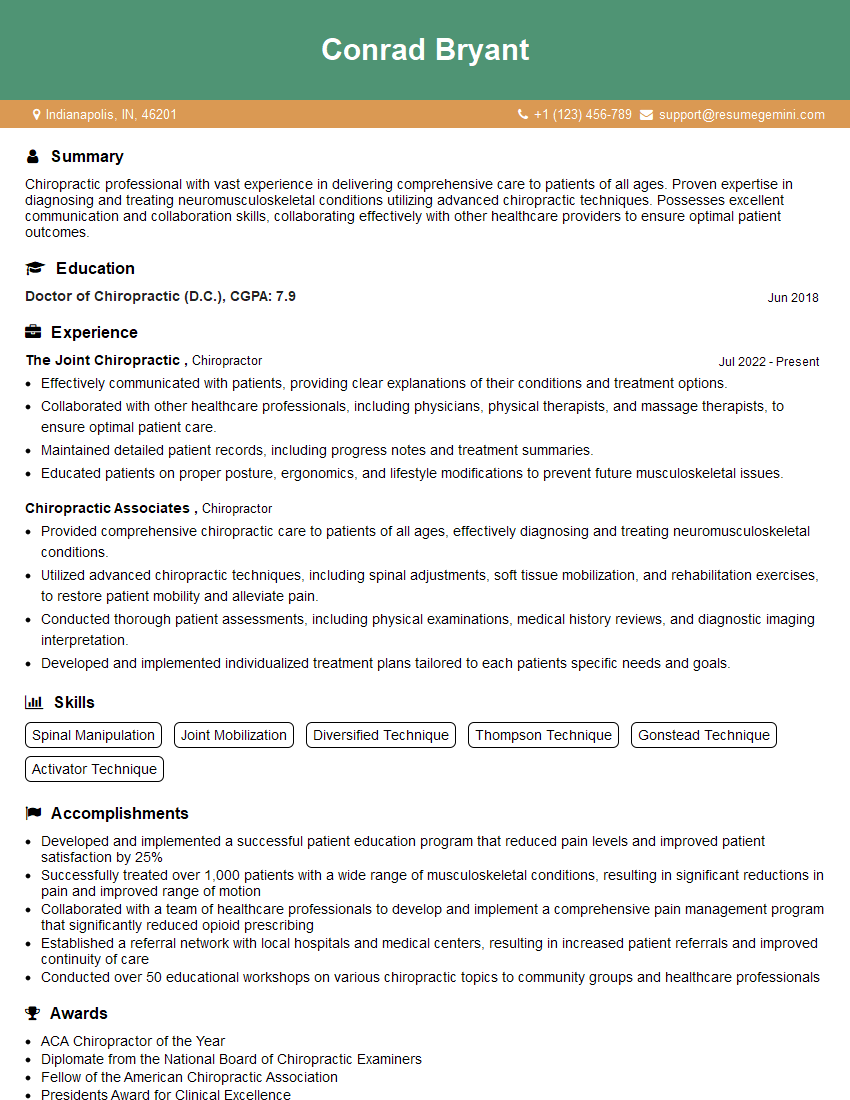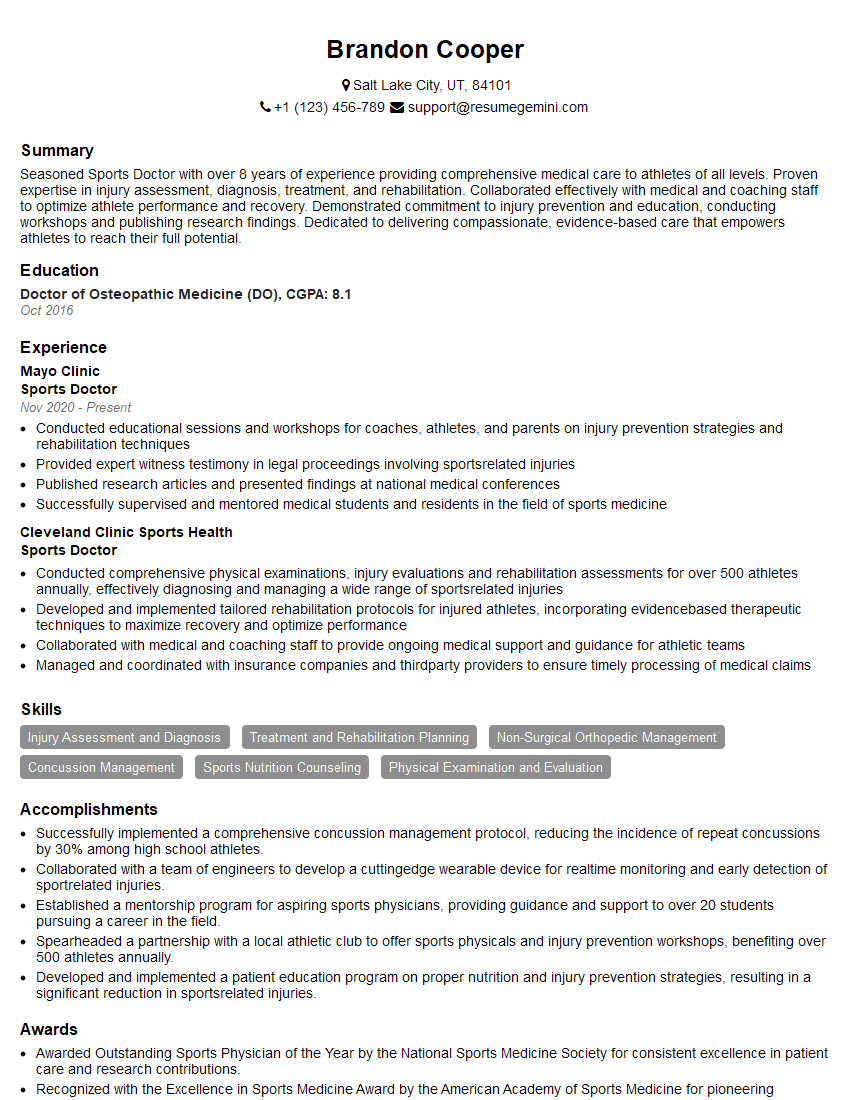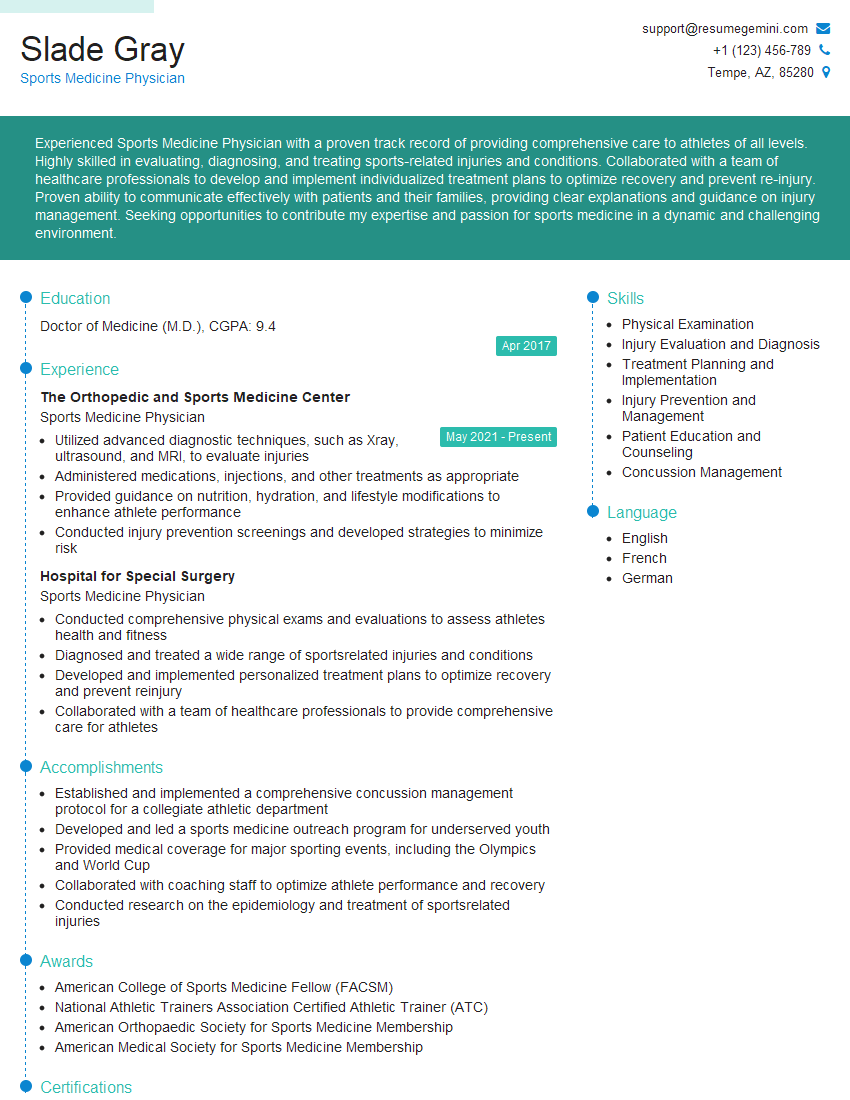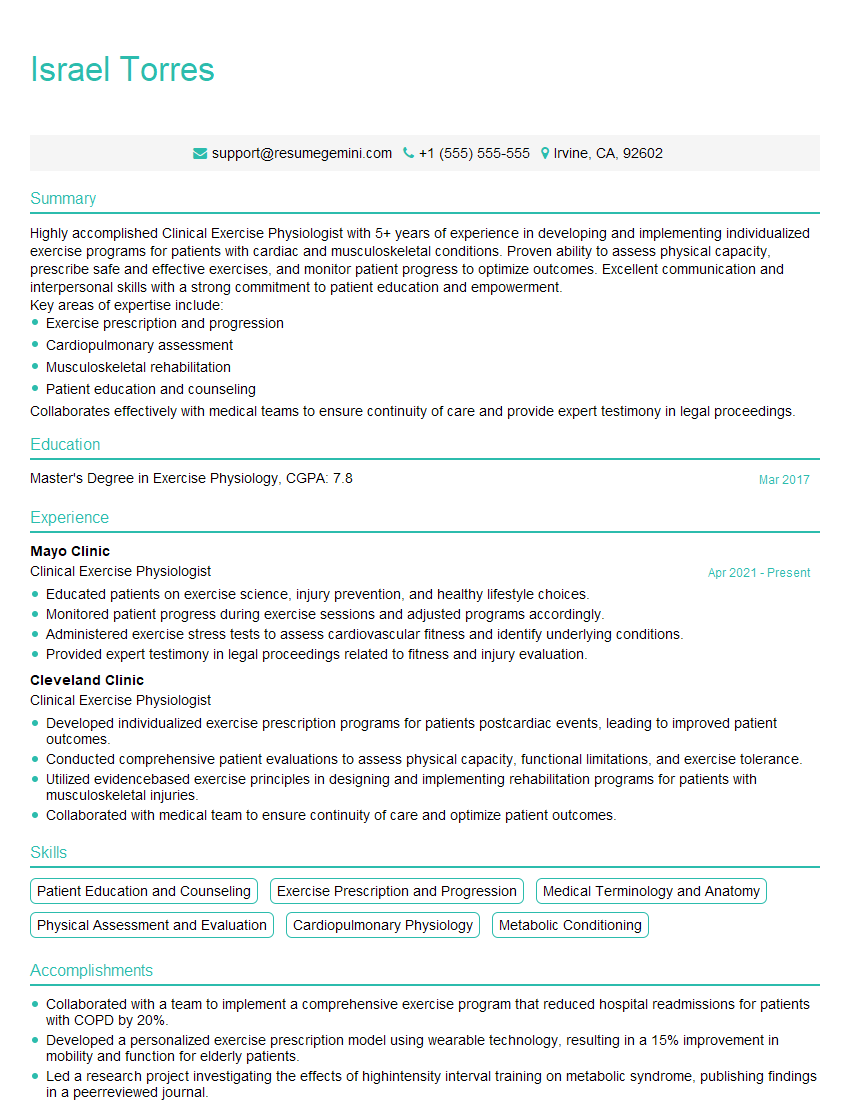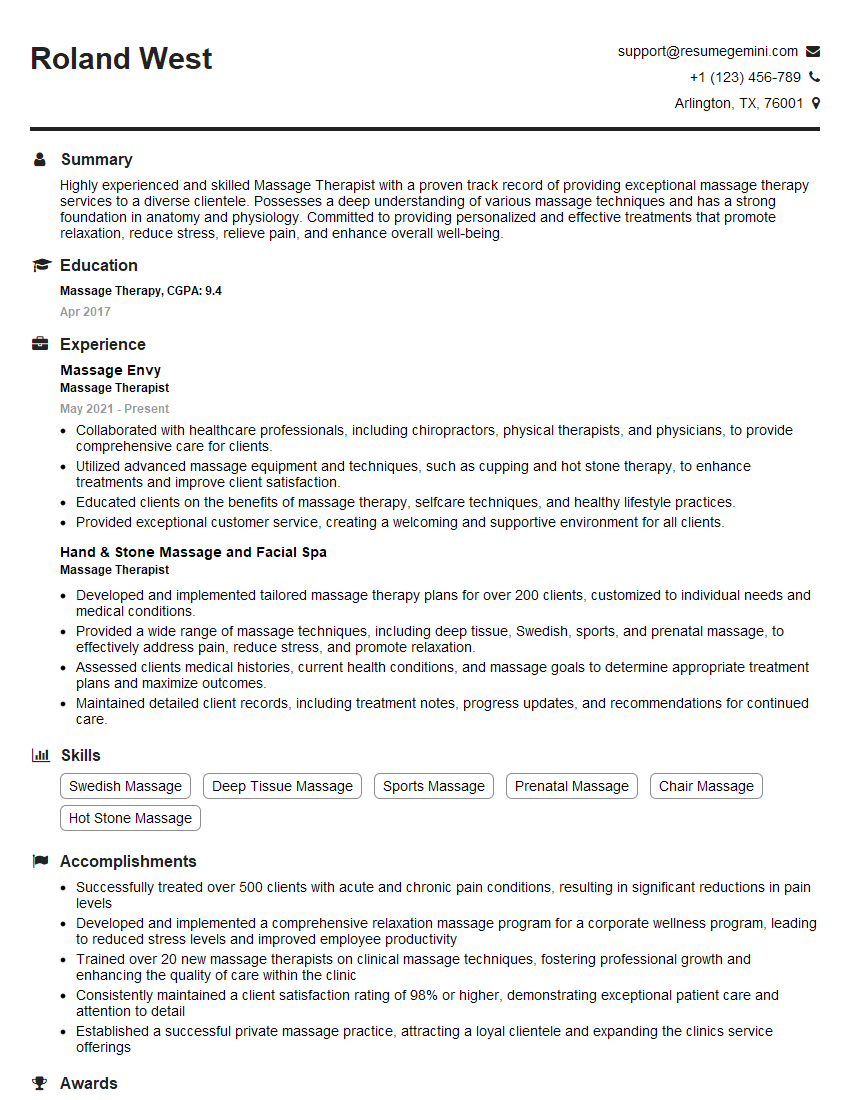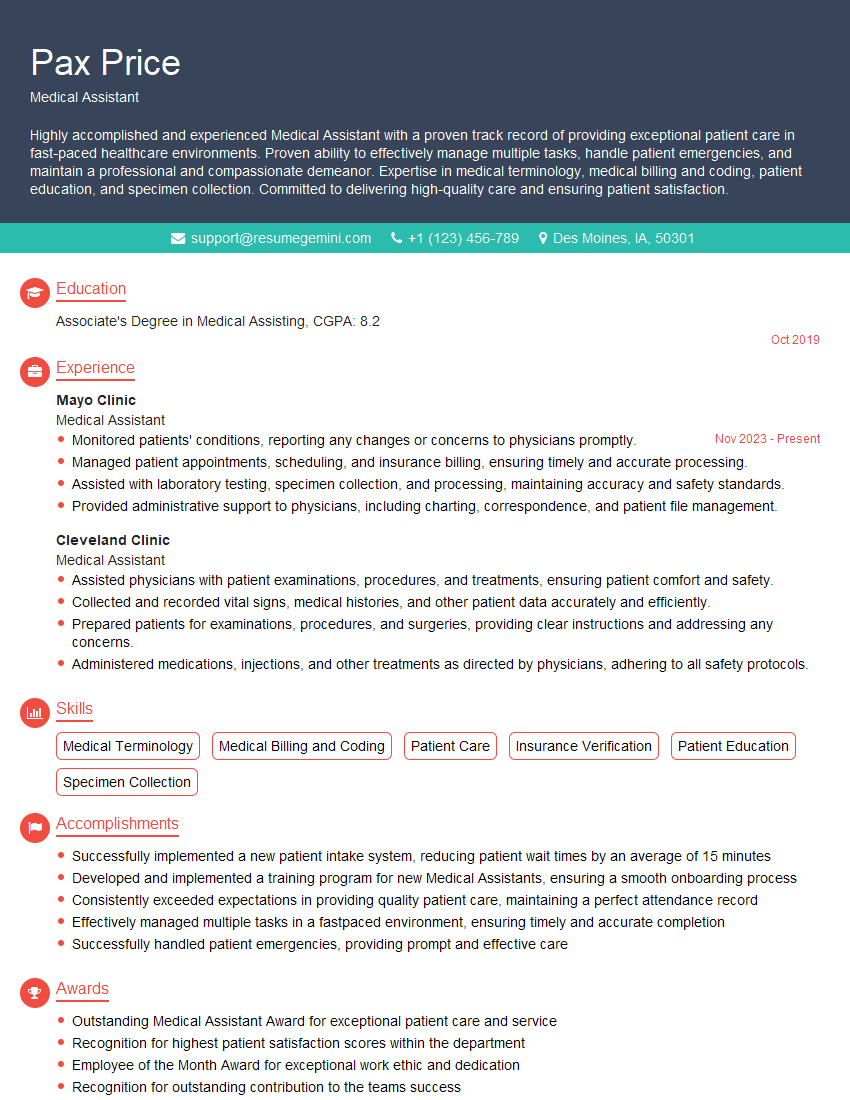The thought of an interview can be nerve-wracking, but the right preparation can make all the difference. Explore this comprehensive guide to Sprains and Strains Treatment interview questions and gain the confidence you need to showcase your abilities and secure the role.
Questions Asked in Sprains and Strains Treatment Interview
Q 1. Explain the difference between a sprain and a strain.
Sprains and strains are both common musculoskeletal injuries, but they affect different tissues. A sprain is an injury to a ligament, the tough band of tissue that connects two bones together at a joint. Think of ligaments as the body’s natural ‘glue’ holding joints stable. A strain, on the other hand, is an injury to a muscle or tendon, which connects muscle to bone. Tendons are like strong ropes that allow muscles to pull on bones to create movement.
Imagine twisting your ankle. If you feel pain and instability, it’s likely a sprain because the ligaments supporting your ankle have been stretched or torn. If you’ve overexerted a muscle during a strenuous workout and feel a sharp pain followed by soreness, it’s more likely a strain because the muscle fibers or tendon have been damaged.
Q 2. Describe the RICE protocol and its application in managing sprains and strains.
The RICE protocol is a widely-used first-aid treatment for sprains and strains. It stands for Rest, Ice, Compression, and Elevation.
- Rest: Avoid activities that aggravate the injury. This allows the damaged tissues to heal and prevents further damage.
- Ice: Applying ice packs for 15-20 minutes at a time, several times a day, helps reduce pain, inflammation, and swelling. Remember to wrap the ice pack in a thin cloth to prevent direct skin contact.
- Compression: A compression bandage helps to reduce swelling by limiting blood flow to the injured area. Apply the bandage snugly but not too tightly, to avoid cutting off circulation.
- Elevation: Keeping the injured area elevated above the heart helps reduce swelling by facilitating fluid drainage. For example, if you sprain your ankle, prop your leg up on pillows.
The RICE protocol is most effective when applied immediately after the injury occurs. It’s a crucial first step before seeking professional medical advice.
Q 3. What are the common signs and symptoms of a grade 2 ankle sprain?
A grade 2 ankle sprain involves a partial tear of one or more ligaments in the ankle. The symptoms are usually more severe than a grade 1 sprain (a mild stretch) but less severe than a grade 3 sprain (a complete tear).
- Significant pain: The pain will be more intense than a minor ankle twist and may be difficult to bear weight on.
- Swelling and bruising: Noticeable swelling and discoloration will be present.
- Instability: The ankle will feel unstable and may give way easily.
- Limited range of motion: Difficulty moving the ankle in various directions will be experienced.
- Possible audible pop or tear during injury: Some individuals report hearing a popping sound at the time of the injury.
It’s crucial to seek medical attention for a grade 2 ankle sprain to ensure proper diagnosis and treatment to prevent long-term instability.
Q 4. How would you assess the severity of a hamstring strain?
Assessing the severity of a hamstring strain involves a careful clinical evaluation. The doctor or physical therapist would assess several factors:
- Pain: The intensity of pain can range from mild discomfort to excruciating pain, indicating the extent of muscle damage.
- Muscle strength: Testing the strength of the hamstring muscles helps to determine the degree of muscle fiber disruption. A significant decrease in strength suggests a more severe strain.
- Range of motion: Assessing the flexibility and range of motion of the affected leg helps determine the extent of the injury.
- Palpation: Feeling the muscle for tenderness and any palpable gaps or deformities can indicate the severity of the muscle tear.
- Swelling: Significant swelling can indicate a severe strain.
In some cases, imaging techniques like MRI may be needed to confirm the diagnosis and determine the precise extent of the damage.
Q 5. What imaging techniques are used to diagnose sprains and strains?
While sprains and strains are often diagnosed clinically based on a physical examination and patient history, imaging techniques can be helpful in confirming the diagnosis and assessing the severity of the injury, particularly in cases of uncertainty or suspected complications.
- X-rays: X-rays are primarily used to rule out fractures, which can often accompany sprains and strains. They will not show soft tissue damage like ligament or muscle tears.
- Ultrasound: Ultrasound imaging uses sound waves to create images of soft tissues. It can visualize muscle tears, ligament damage, and tendon injuries relatively inexpensively and non-invasively.
- MRI (Magnetic Resonance Imaging): MRI provides the most detailed images of soft tissues. It’s particularly useful for assessing the extent of ligament tears, muscle damage, and tendon injuries, offering superior detail to ultrasound.
The choice of imaging technique depends on the clinical suspicion, the severity of the injury, and the availability of resources.
Q 6. Discuss the role of physiotherapy in the rehabilitation of a knee sprain.
Physiotherapy plays a vital role in the rehabilitation of a knee sprain. A well-structured physiotherapy program aims to reduce pain and inflammation, restore range of motion, improve muscle strength and stability, and ultimately return the individual to their pre-injury functional level.
The physiotherapy program will typically involve:
- Early-stage treatment: Focusing on pain management using modalities like ice, ultrasound, and electrical stimulation, along with gentle range-of-motion exercises to prevent stiffness.
- Strengthening exercises: Targeted exercises will focus on strengthening the muscles surrounding the knee joint, particularly the quadriceps, hamstrings, and calf muscles, thereby improving stability.
- Proprioceptive training: This involves exercises that improve balance and coordination, helping to regain control and stability of the knee joint. Examples include balance board exercises or standing on one leg.
- Functional exercises: As the knee heals, exercises mimicking everyday activities like walking, stair climbing, and jumping are gradually introduced to help the patient regain full function.
- Return-to-sport program: For athletes, a carefully designed program guides the gradual return to sporting activities.
The duration and intensity of physiotherapy depend on the severity of the sprain and the individual’s response to treatment.
Q 7. What are the contraindications for applying heat therapy to a sprain?
Applying heat therapy to a sprain is generally contraindicated in the acute phase (the initial 24-72 hours) of the injury. Heat can increase blood flow and inflammation, which can worsen swelling, pain, and potentially delay healing.
Other contraindications for heat therapy include:
- Active bleeding or open wounds: Heat can increase bleeding in the affected area.
- Areas with compromised circulation: For instance, individuals with diabetes or peripheral artery disease might experience reduced healing or complications from heat therapy.
- Certain skin conditions: Heat should be avoided in areas with skin infections, open sores, or burns.
- Lack of sensation in the affected area: The person may not be able to sense the heat and risk a burn.
Heat therapy can be beneficial in the subacute or chronic phase of a sprain to promote tissue healing and relaxation when swelling is reduced, but only under the guidance of a healthcare professional.
Q 8. Explain the importance of proper immobilization in the initial management of a strain.
Proper immobilization in the initial management of a strain is crucial for minimizing further injury and promoting optimal healing. Think of it like this: if you sprain your ankle, continued movement can further damage the already stretched or torn muscle fibers. Immobilization, usually achieved with a splint, brace, or sling, reduces stress on the injured area, allowing the tissues to begin the repair process. This reduces pain, inflammation, and prevents potential complications like chronic instability.
The degree of immobilization depends on the severity of the strain. A mild strain might only require rest and avoidance of aggravating activities, while a more severe strain may necessitate a cast or brace for several weeks. Early mobilization, guided by a physical therapist, is equally crucial to avoid stiffness and to promote a return to function.
Q 9. Describe the different stages of tissue healing following a sprain.
Tissue healing after a sprain follows a predictable sequence:
- Inflammation Phase (Days 1-10): This is the body’s initial response to injury. You’ll see swelling, redness, pain, and loss of function. The body is working to clean up debris and prepare for repair.
- Proliferation Phase (Days 10-21): New blood vessels form (angiogenesis), and collagen (a key structural protein) starts to rebuild damaged tissues. This is a crucial phase for proper healing, and gentle movement can promote this.
- Remodeling Phase (Weeks 3-6 and beyond): Collagen fibers realign, strengthening the injured tissue. This phase can continue for several months, and the tissue’s strength gradually increases. Proper rehabilitation is vital to ensure optimal strength and reduce the risk of re-injury.
It’s important to note that these phases overlap, and the duration of each phase can vary depending on the severity of the sprain and individual factors like age and overall health.
Q 10. How do you differentiate between a muscle strain and a tendon tear?
Differentiating between a muscle strain and a tendon tear requires a careful clinical examination and sometimes imaging (like ultrasound or MRI). A muscle strain involves a stretch or tear in the muscle itself, while a tendon tear involves damage to the tough, fibrous tissue that connects muscle to bone.
- Muscle Strain: Usually characterized by pain localized to the muscle belly (the fleshy part of the muscle), with tenderness to the touch and possible muscle spasms. The range of motion may be limited, but often some movement is possible.
- Tendon Tear: Often presents with more severe pain, localized directly at the tendon insertion point (where the tendon attaches to the bone). There might be significant loss of function and a palpable defect (a gap) in the tendon in severe cases.
A complete tear usually involves a palpable gap and inability to use the affected muscle, whereas strains show varying degrees of pain and decreased function but still some movement is possible. Imaging studies can confirm the diagnosis and assess the extent of the injury.
Q 11. What are the potential complications of inadequately treated sprains and strains?
Inadequate treatment of sprains and strains can lead to several complications:
- Chronic Pain: Incomplete healing can result in persistent pain and discomfort, impacting daily activities.
- Instability: Improperly healed ligaments (in sprains) can leave the joint unstable, increasing the risk of re-injury and further damage.
- Muscle Weakness and Atrophy: Lack of rehabilitation can lead to weakened muscles surrounding the injured area, making it more susceptible to further injury.
- Arthritis: Severe or repeated sprains can contribute to the development of osteoarthritis over time.
- Complex Regional Pain Syndrome (CRPS): A rare but debilitating condition characterized by chronic pain, swelling, and changes in skin temperature and color. This is more likely if the initial injury wasn’t treated properly.
Early intervention and proper rehabilitation are essential to minimize these risks.
Q 12. Explain the concept of functional rehabilitation in the context of sprains and strains.
Functional rehabilitation focuses on restoring the injured area’s function and returning the patient to their pre-injury level of activity. Unlike passive rehabilitation, which may involve just range-of-motion exercises, functional rehabilitation emphasizes activities that mimic real-world movements. This approach aims for a faster, more complete recovery.
For example, someone who has sprained their ankle would progress through exercises designed to improve balance, agility, and proprioception (the body’s sense of position and movement) before eventually returning to sports or other activities involving running and jumping. The goal isn’t just healing the sprain itself, but returning the ankle to its full capability.
Q 13. What are the common risk factors for sprains and strains?
Several factors increase the risk of sprains and strains:
- Poor Physical Condition: Weak muscles, poor flexibility, and lack of proper conditioning increase the strain on joints and muscles during activities.
- Improper Warm-up: Failing to adequately warm up before exercise leaves muscles less pliable and more prone to injury.
- Inappropriate Footwear: Wearing inadequate or worn-out shoes can increase the risk of ankle sprains and other lower extremity injuries.
- Previous Injury: A history of sprains or strains in the same area increases the risk of future injuries.
- Certain Sports and Activities: High-impact sports and activities that involve sudden twisting or forceful movements place considerable stress on the musculoskeletal system.
- Underlying Medical Conditions: Conditions like arthritis or certain neuromuscular disorders can increase susceptibility.
Addressing these risk factors through regular exercise, proper warm-up routines, and appropriate protective equipment can significantly reduce the likelihood of sprains and strains.
Q 14. How would you educate a patient on the prevention of ankle sprains?
Educating a patient on ankle sprain prevention involves a multifaceted approach:
- Strengthening Exercises: Recommend exercises that strengthen the muscles surrounding the ankle joint, including calf raises, toe raises, and ankle inversion/eversion exercises. These exercises improve stability and reduce the likelihood of sprains.
- Stretching: Regular stretching of the calf muscles and ankle ligaments improves flexibility and reduces the risk of injury.
- Proprioceptive Exercises: Include exercises that improve balance and coordination. These could range from simple single-leg stances to more complex balance board exercises. Improving proprioception enhances the ankle’s ability to respond to unexpected movements.
- Proper Footwear: Emphasize the importance of wearing supportive, well-fitting shoes with good ankle support, especially during activities that increase the risk of sprains.
- Safe Practices: Advise patients to be aware of their surroundings, avoid uneven surfaces, and pay attention to their body’s signals. Rest and avoid activities when feeling pain.
Combining these preventative measures can significantly reduce the risk of ankle sprains. It’s crucial to make the education patient-centric and tailor it to their individual activity level and risk factors.
Q 15. Describe the different types of bracing or supports used for sprains and strains.
Bracing and support play a crucial role in managing sprains and strains by providing stability to the injured joint or muscle, reducing pain, and promoting healing. The type of support used depends on the severity of the injury and the specific location.
- Ankle braces: These range from simple elastic bandages to more rigid supports with adjustable straps, offering varying levels of stability for ankle sprains. A lace-up ankle brace provides more support than a simple sleeve.
- Knee braces: These can be hinged or non-hinged, offering support for knee sprains and ligament injuries. Hinged braces offer more control and restriction of movement.
- Wrist splints: These immobilize the wrist and can be useful for wrist sprains or tendon injuries. They can be soft, providing compression and support, or rigid, offering more immobilization.
- Sleeves and wraps: Elastic sleeves or wraps provide compression and support for less severe injuries to the arm, leg, or other body parts. They improve blood flow and reduce swelling.
- Shoulder slings: Used for shoulder injuries, these support the arm and keep it immobile, allowing for healing of rotator cuff injuries or dislocations.
The choice of brace is determined through a thorough clinical assessment of the patient’s injury, considering factors such as pain level, joint stability, and the need for range of motion restriction. It’s crucial to ensure proper fitting to maximize effectiveness and avoid further injury.
Career Expert Tips:
- Ace those interviews! Prepare effectively by reviewing the Top 50 Most Common Interview Questions on ResumeGemini.
- Navigate your job search with confidence! Explore a wide range of Career Tips on ResumeGemini. Learn about common challenges and recommendations to overcome them.
- Craft the perfect resume! Master the Art of Resume Writing with ResumeGemini’s guide. Showcase your unique qualifications and achievements effectively.
- Don’t miss out on holiday savings! Build your dream resume with ResumeGemini’s ATS optimized templates.
Q 16. What are the limitations and potential benefits of using NSAIDs for managing pain associated with sprains and strains?
Nonsteroidal anti-inflammatory drugs (NSAIDs) like ibuprofen and naproxen are commonly used to manage pain and inflammation associated with sprains and strains. While effective in reducing pain and swelling, they have limitations and potential side effects.
- Benefits: NSAIDs effectively reduce pain and inflammation, enabling increased comfort and mobility, and allowing patients to participate more effectively in rehabilitation exercises.
- Limitations: NSAIDs can cause gastrointestinal issues such as stomach upset, ulcers, and bleeding, especially with prolonged use. They can also affect kidney function and increase the risk of cardiovascular events in some individuals. They don’t address the underlying cause of the injury; they only manage the symptoms.
Therefore, NSAIDs should be used judiciously, under the guidance of a healthcare professional. They should be used for a limited duration, along with other treatment modalities like rest, ice, compression, elevation (RICE), and physical therapy. The potential benefits must always be weighed against the risks, especially for patients with pre-existing medical conditions.
Q 17. Explain the role of strengthening and flexibility exercises in rehabilitation.
Strengthening and flexibility exercises are cornerstones of rehabilitation for sprains and strains. They help restore muscle strength, improve joint stability, and increase range of motion, preventing future injuries.
- Strengthening Exercises: These exercises target the muscles surrounding the injured area, gradually increasing the load and intensity as the healing progresses. For example, after an ankle sprain, exercises might include calf raises, ankle pumps, and resistance band exercises. For a hamstring strain, exercises may include hamstring curls and bridges.
- Flexibility Exercises: These exercises improve the range of motion in the affected joint and help reduce muscle stiffness and tightness. Examples include gentle stretches for the hamstrings, calf muscles, or rotator cuff, depending on the location of the injury. These exercises are essential to regain full function and reduce risk of re-injury.
A properly designed rehabilitation program progresses gradually, starting with gentle range of motion exercises and gradually progressing to more challenging strengthening and flexibility exercises. It is essential to tailor the program to the individual’s specific needs and healing process, closely monitoring for pain and any setbacks.
Q 18. Discuss the use of modalities such as ultrasound and electrical stimulation in the treatment of sprains and strains.
Modalities like ultrasound and electrical stimulation can be beneficial adjunctive therapies in the management of sprains and strains, but they are not standalone treatments.
- Ultrasound: Uses high-frequency sound waves to generate heat deep within tissues. This heat can improve blood flow, reduce inflammation, and promote tissue healing. It can provide pain relief and accelerate the healing process.
- Electrical Stimulation: Uses electrical currents to stimulate muscles and nerves. This can reduce pain, decrease muscle spasm, and improve muscle function. Different types of electrical stimulation (e.g., TENS, NMES) have different effects.
These modalities are most effective when combined with other treatment approaches, such as rest, ice, compression, elevation, and a structured rehabilitation program. The use of these modalities should always be under the supervision of a qualified healthcare professional, who will tailor the treatment to the specific needs of the patient.
Q 19. How do you assess the patient’s functional capacity during rehabilitation?
Assessing a patient’s functional capacity during rehabilitation is crucial to determining their progress and readiness to return to normal activities. This assessment involves a combination of subjective and objective measures.
- Subjective Assessment: Involves asking the patient about their pain levels, ability to perform daily activities, and any limitations they experience. We use standardized questionnaires like the Oswestry Disability Index to quantify functional limitations.
- Objective Assessment: Involves measuring the patient’s range of motion (using a goniometer), muscle strength (using manual muscle testing or dynamometry), and balance (using a balance scale). Functional tests, such as walking tests or stair climbing tests, assess the ability to perform activities of daily living.
By combining subjective and objective assessments, we gain a comprehensive understanding of the patient’s progress and can adjust the rehabilitation plan accordingly. We ensure that the patient can safely and effectively perform activities before progressing to higher levels of functional capacity. This process ensures that we avoid re-injury and promote a safe return to daily life and work.
Q 20. What are the signs of infection following a sprain or strain?
Infection following a sprain or strain is rare but can occur if the skin is broken. Signs of infection include:
- Increased pain and swelling: More significant than initially experienced, and out of proportion to the injury.
- Redness and warmth around the injured area: The skin may become noticeably red and feel warm to the touch.
- Pus or drainage: The presence of pus or other fluid draining from the wound indicates infection.
- Fever or chills: Systemic signs of infection include fever, chills, and general malaise.
- Red streaks extending from the wound: This indicates that the infection has spread along the lymphatic system.
If any of these signs are present, it is crucial to seek immediate medical attention. Early intervention with antibiotics is vital to prevent the infection from spreading and causing more serious complications.
Q 21. How do you manage a patient who experiences persistent pain despite appropriate treatment?
Persistent pain despite appropriate treatment requires a thorough reevaluation of the patient’s condition. Several factors could be contributing to the persistent pain.
- Incomplete Healing: The injury may not have healed completely, requiring a longer period of rehabilitation or alternative treatment approaches.
- Underlying Conditions: The persistent pain could be related to other underlying conditions, such as nerve compression, arthritis, or referred pain.
- Chronic Pain Syndrome: The pain may have become chronic, requiring a multidisciplinary approach involving pain management specialists, physiotherapists and psychologists.
- Inadequate Treatment: The initial treatment plan may have been inadequate, requiring modification or a change in approach.
- Psychological Factors: Anxiety, depression, or other psychological factors can exacerbate the pain experience.
Managing a patient with persistent pain requires a careful reassessment of the injury, including imaging studies (X-rays, MRI) to rule out other conditions, considering other pain management strategies (e.g., nerve blocks, trigger point injections), and possibly referring the patient to a pain management specialist or psychologist for a comprehensive approach to pain management.
Q 22. Discuss your experience with different rehabilitation programs for various types of sprains and strains.
Rehabilitation programs for sprains and strains are highly individualized, depending on the severity of the injury, the affected joint, and the patient’s overall health. My experience encompasses a wide range of approaches, from simple RICE (Rest, Ice, Compression, Elevation) protocols for mild injuries to comprehensive programs involving therapeutic exercises, manual therapy, and modalities like ultrasound or electrical stimulation for more severe cases.
Mild ankle sprain: A patient with a mild ankle sprain might begin with RICE, followed by gradual range-of-motion exercises and proprioceptive training (exercises to improve balance and coordination). We’d progress to weight-bearing exercises and finally, return to their pre-injury activity levels.
Moderate hamstring strain: For a moderate hamstring strain, the initial phase focuses on pain management and reducing inflammation. This might involve ice, gentle stretching, and low-impact cardio like cycling. As pain subsides, we’d introduce strengthening exercises targeting the hamstrings and surrounding muscles, gradually increasing resistance and intensity. Finally, sport-specific drills would be incorporated to ensure a safe return to activity.
Severe rotator cuff tear: A severe rotator cuff tear often requires a more complex rehabilitation plan, potentially including physical therapy several times a week, possibly incorporating advanced techniques like neuromuscular electrical stimulation (NMES) to promote muscle re-education. The focus would be on regaining range of motion, restoring strength, and improving functional abilities. This might take several months.
Throughout all programs, patient education is key. I emphasize the importance of adherence to the plan, proper exercise technique, and recognizing warning signs of re-injury.
Q 23. How would you adapt treatment plans for different age groups and activity levels?
Adapting treatment plans for different age groups and activity levels is crucial for successful rehabilitation. Children, for example, often heal faster but may require modifications to exercises to accommodate their developing musculoskeletal system. Older adults, on the other hand, might have pre-existing conditions or decreased bone density, requiring a more cautious approach with a focus on maintaining functional independence.
Children: We use play-based activities to make exercises fun and engaging. We might incorporate games or incorporate the exercises into activities they enjoy. We also need to be mindful of their growth plates.
Older adults: The focus might be on improving daily living activities like walking, climbing stairs, or getting up from a chair. Exercises need to be adapted to their physical capabilities and any co-morbidities, and I emphasize safety to avoid falls.
Highly active individuals: Athletes and individuals with high activity levels require a more rigorous and targeted program focusing on sport-specific exercises and rapid functional recovery. We need to consider the demands of their activity and ensure a gradual return to avoid re-injury.
Sedentary individuals: We must begin with a lower intensity and volume and progress slowly. The focus might be on building a foundational level of strength and endurance before progressing to more challenging exercises.
Regular communication and ongoing assessment of the patient’s progress are essential to ensure the plan remains appropriate and effective.
Q 24. Describe your approach to communicating effectively with patients regarding their treatment plan and prognosis.
Effective communication is paramount. I use clear, concise language, avoiding medical jargon whenever possible. I explain the injury, the treatment plan, and the expected prognosis in a way the patient can readily understand. I encourage questions and actively listen to their concerns.
I use visual aids, such as diagrams or videos, to help explain complex concepts. I also provide written materials summarizing the treatment plan, exercises, and any home care instructions. For example, I might show a patient a video demonstrating proper stretching techniques for their hamstring strain. I always check for understanding using the ‘teach-back’ method: I ask the patient to explain the plan in their own words to ensure they grasp the key elements.
Regular follow-up appointments allow me to monitor progress, address any questions or concerns, and adjust the plan as needed. Open and honest communication builds trust and fosters a collaborative approach to rehabilitation.
Q 25. What are the key elements you consider when selecting appropriate therapeutic exercises?
Selecting appropriate therapeutic exercises involves careful consideration of several key elements:
Patient’s condition: The type and severity of the injury, the presence of any other medical conditions, and the patient’s pain level.
Functional goals: What activities does the patient want to return to? Exercises should be tailored to help them achieve their specific goals.
Pain level: Exercises should not exacerbate pain. We start with pain-free ranges of motion and gradually increase the intensity as tolerated.
Progressive overload: Exercises should gradually increase in intensity and duration to challenge the muscles and promote healing and adaptation.
Specificity: Exercises should be specific to the injured area and target the muscles involved in the activity the patient wants to perform.
Safety: Proper form and technique are essential to avoid re-injury. I always demonstrate and supervise exercises, especially initially.
For instance, for a knee sprain, I might initially focus on range-of-motion exercises, followed by isometrics (muscle contractions without movement), then isotonics (muscle contractions with movement) and finally plyometrics (jump training) as the patient’s strength and stability improve.
Q 26. How do you assess the patient’s understanding of their condition and treatment plan?
Assessing a patient’s understanding involves several strategies:
Open-ended questions: I ask the patient to explain their understanding of their condition and the treatment plan in their own words.
Teach-back method: I ask the patient to demonstrate or explain the exercises they’ve been taught.
Visual aids: I use diagrams, models, or videos to confirm understanding of anatomical structures and treatment processes.
Written materials: Providing written instructions reinforces the information discussed verbally.
Follow-up questions: I ask clarifying questions throughout the session to identify any areas of confusion.
If a patient demonstrates misunderstanding, I re-explain the information using different methods and provide additional resources.
Q 27. How do you handle a situation where a patient’s progress plateaus during rehabilitation?
When a patient’s progress plateaus, a thorough reassessment is necessary. This involves reviewing the treatment plan, the patient’s adherence to the program, and any potential underlying factors impacting recovery.
Re-evaluation: A comprehensive physical examination assesses the joint’s range of motion, strength, and stability. Pain assessments are performed.
Imaging review: Reviewing existing imaging studies or obtaining new ones may identify previously undetected issues.
Modifications to the plan: Based on the reassessment, adjustments are made to the treatment plan. This might include modifying exercises, changing the intensity or frequency, or adding new modalities.
Referral: If the plateau persists despite modifications, a referral to another specialist, such as an orthopedist or neurologist, may be needed to rule out other contributing factors.
Addressing psychosocial factors: Sometimes, psychological factors, such as fear of re-injury or depression, can hinder recovery. Addressing these factors through counseling or other support may be necessary.
Open communication with the patient is vital throughout this process, ensuring they understand the reason for the plateau and the plan to address it.
Q 28. Explain your understanding of evidence-based practice in the treatment of musculoskeletal injuries.
Evidence-based practice (EBP) is central to my approach. It means integrating the best available research evidence with clinical expertise and patient values to make informed decisions about treatment. I regularly review the latest scientific literature on sprains and strains, focusing on studies that assess the effectiveness of different interventions.
For example, I wouldn’t prescribe an intervention without strong evidence supporting its efficacy and safety for the specific injury. Instead, my approach would be guided by high-quality randomized controlled trials and systematic reviews. I would avoid outdated techniques not supported by current evidence. Furthermore, I tailor my approach to individual patient needs and preferences. I consider their cultural background, beliefs, and personal circumstances when designing a treatment plan.
EBP ensures that patients receive the most effective and safe care, based on the best available science, coupled with my experience and the patient’s input. This approach leads to improved patient outcomes and a higher quality of care.
Key Topics to Learn for Sprains and Strains Treatment Interview
- Anatomy and Physiology: Understanding the musculoskeletal system, including ligaments, tendons, muscles, and joints, is fundamental. Focus on the structures commonly affected by sprains and strains.
- Mechanism of Injury: Learn to differentiate between sprains and strains based on the mechanism of injury and the affected structures. Be prepared to discuss common injury patterns.
- Clinical Presentation: Master the assessment of patients presenting with sprains and strains, including history taking, physical examination techniques (e.g., range of motion, palpation), and identification of key symptoms.
- Diagnostic Imaging: Familiarize yourself with the role and interpretation of various imaging modalities (X-ray, MRI, ultrasound) in diagnosing sprains and strains. Understand when imaging is necessary and what it can reveal.
- Treatment Modalities: Develop a strong understanding of conservative treatment approaches, including RICE (rest, ice, compression, elevation), pain management (pharmacological and non-pharmacological), and rehabilitation strategies (physical therapy, exercises).
- Surgical Interventions: While less common for simple sprains and strains, be aware of the indications and procedures for surgical intervention in complex or severe cases.
- Rehabilitation and Recovery: Detail the principles of rehabilitation, including progressive exercise programs, functional restoration, and return-to-activity guidelines. Understand factors influencing recovery time.
- Differential Diagnosis: Practice differentiating sprains and strains from other musculoskeletal conditions with similar presentations, ensuring accurate diagnosis and appropriate treatment planning.
- Patient Education and Counseling: Discuss the importance of patient education and counseling in promoting adherence to treatment plans and facilitating a successful recovery.
- Complication Management: Understand potential complications associated with sprains and strains, such as chronic pain, instability, and nerve injury, and how to manage them.
Next Steps
Mastering Sprains and Strains Treatment demonstrates a strong foundation in musculoskeletal care, significantly enhancing your career prospects in various healthcare settings. To increase your chances of landing your dream job, crafting an ATS-friendly resume is crucial. ResumeGemini is a trusted resource that can help you build a professional and impactful resume, highlighting your skills and experience effectively. Examples of resumes tailored to Sprains and Strains Treatment are available to guide you.
Explore more articles
Users Rating of Our Blogs
Share Your Experience
We value your feedback! Please rate our content and share your thoughts (optional).
What Readers Say About Our Blog
This was kind of a unique content I found around the specialized skills. Very helpful questions and good detailed answers.
Very Helpful blog, thank you Interviewgemini team.




